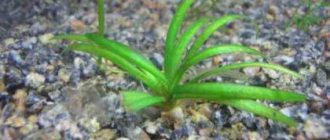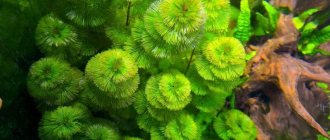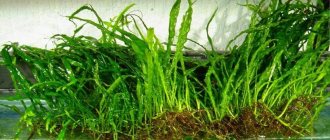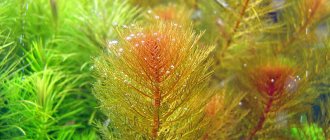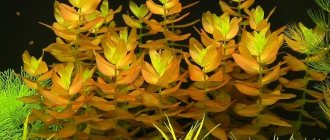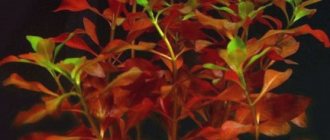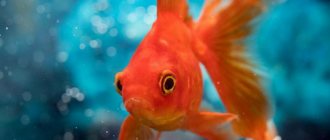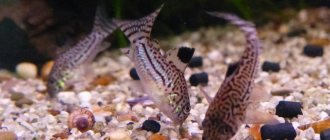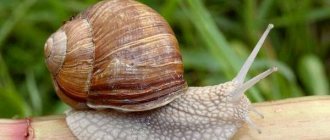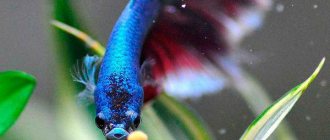Ludwigia is a tropical aquarium plant of the fireweed family. It has hundreds of varieties, differing from each other in size, color and complexity of content. Aquarists can choose Ludwigia to suit their taste, ranging from easy-to-care - swamp and creeping, which take root in almost any conditions, to the rare and whimsical Ludwigia white.
| Ludwigia | Temperature | pH of the environment | Hardness of water | Illumination | Aquarium size | Growth rate | Difficult to care for |
| Creeping | 4-28°С | 5.0-7.0 | 2–15°dGH | Medium\High | Big | High | Just |
| Bolotnaya | 4-28°С | 5.0-8.0 | 2–22°dGH | Medium\High | Big | High | Just |
| Mexico City | 4-28°С | 4.0-7.0 | 0-14°dGH | Medium\High | Big | High | Just |
| Glandular | 10–27°С | 5.5–7.0 | 2–10°dGH | High | Big | Average | Difficult |
| Red | 18-30°C | 5.0–7.0 | 0–8°dGH | High | Big | High | Difficult |
| Senegalese | 12-30°C | 4.0-7.0 | 0-7°dGH | High | Big | Average | Just |
| Ruby | 6-32°С | 4.0-7.0 | 2-15°dGH | Medium\High | Big | High | Just |
| Brevipes | 12-28°C | 4.0-7.0 | 2-10°dGH | Medium\High | Any | High | Just |
| Marilia | 20-28°С | 5.0-7.0 | 2-10°dGH | High | Any | High | Just |
| Arc-shaped | 12-28°C | 4.0–7.5 | 2-15°dGH | Medium\High | Any | High | Just |
| Inclinata | 22-27°C | 5.5-7.5 | 5-16° dGH | High | Big | High | Difficult |
| Peruvian | 22-27°C | 6,5-7,5 | 4-10° dGH | High | Big | High | Average |
| floating | 15-32°С | 6.0–7.5 | 2–15°dGH | High | Not suitable for aquarium | High | Difficult |
| Tornado | 18-30°C | 5.0–7.0 | 0–8°dGH | High | Big | High | Average |
| Ovalis | 10-28°C | 4.0–7.0 | 0–7°dGH | Medium\High | Big | High | Average |
| Pylos | 22-30°C | 6.0-7.0 | dGH 4-12° | High | Big | Low | Difficult |
Description and features
Habitat
Ludwigia is found almost everywhere, except for the extremely hot and cold points of the planet. This plant prefers moist, warm climates and can often be found in the wild along the edges of swamps, lakes or streams. The most popular types of Ludwigia for aquariums are imported from South and Central America.
Appearance
Ludwigias can have completely different appearances due to their diversity, but the distinctive feature of most is their bright leaves, which only show themselves if they are under water and if they are properly cared for. The range of colors can be very different, ranging from soft pink to bright orange and dark burgundy.
Why isn't it growing?
There are several reasons why Ludwigia starts to get sick and stops developing:
- malnutrition;
- lack of lighting;
- too cold water in the aquarium;
- dirty water.
As soon as you eliminate the cause, the plant will begin to grow rapidly and change the color of the leaves. It is necessary to focus on the characteristics of the content of the Ludwigia variety, only then you will be able to admire the plant for a long time. Some species like harder water, others need it very warm, and the floating species is demanding on lighting.
Popular types
The variety of Ludwigia species allows you to choose the right plant for both beginners and experienced aquarists.
Ludwigia creeping
Ludwigia repens - Ludwigia repens. The most popular species among aquarists. Many people fell in love with creeping ludwigia for its ease of maintenance and pleasant appearance that decorates aquariums. The stem of creeping ludwigia rises vertically up to the water's edge, after which it spreads on the surface. It is because of this that this species received the name “creeping” - the stem seems to “crawl” along the surface of the water.
Habitat: North and Central America.
Characteristics: The stem reaches half a meter in height. The leaves are dense, glossy, elliptical in shape. With proper care, the color is bright red, rich or even burgundy. It has many varieties and hybrids that the average person is unlikely to be able to distinguish from each other.
Features of the content: The soil should have a low concentration of NO3 (from 5 ml/l), a high content of PO4 (1.5-2 ml/l) and iron. The brighter the lighting, the more shoots there are, the more they curl in different directions, often bending under their own weight and settling to the bottom.
Ludwigia swamp
Ludwigia palustris - Ludwigia palustris. Quite changeable. It has many decorative forms, which later became separate species with specific conditions of detention.
Habitat: almost all marshy areas of the globe. Recently it was brought to Australia, first as an ornamental plant, after which it accidentally ended up in the wild and successfully took root there.
Characteristics: Depending on the subspecies, the color of the leaves may differ: either bright red or dark green. If the plant grows above water, it may develop sepal flowers with four yellow stamens without petals. The plant itself grows up to half a meter. The leaves are elongated, oval, pointed towards the end and are arranged strictly in twos on one interval of the stem.
Features of the content: swamp ludwigia can grow in any light, but it is recommended to maintain bright light to maintain the length and color of the leaves. The soil should be rich in nitrates and phosphates. Swamp ludwigia does not react well to carbon dioxide. Swamp ludwigia itself is unpretentious and can withstand fluctuations in acidity and water hardness.
Ludwigia Mexico City
Ludwigia repens "Mesakana" is a variety of creeping ludwigia. The name comes from the region where the species was discovered.
Habitat: Mainly in Mexico.
Characteristics: outwardly resembles creeping ludwigia, differing in the size and shape of the leaves. The leaves are large, the color is yellow-red at the top of the stem. The lower leaves are green. Sprouts often die when trying to plant them, so for propagation you need to take extra material.
Features of the content: like its ancestor - creeping Ludwigia, Mexican is extremely unpretentious in maintenance. It can be grown in almost any conditions, but for the bright appearance of color and the appearance of new shoots, a high level of lighting and maintaining the pH in the water are necessary.
Ludwigia Glandulosa
Ludwigia glandulosa – often colloquially called Ludwigia glandulosa. It is also called Himalayan, or Ludwigia perennis. One of the most prominent representatives of its species.
Habitat: North America, southeastern United States. It often grows in bodies of water with stagnant water, such as swamps and lakes.
Characteristics: like the previous Ludwigias, the ferruginous Ludwigia can grow both above and below water. Its brightest colors appear only when it is immersed in water. The stem of the glandulose is straight and vertical. Leaves are lanceolate-elongated. Color – varies in different shades of red.
Features Contents: Glandulose is a very fastidious plant. Bright lighting is required, the water is soft and acidic. Soil saturated with iron. It is also very important that there is no internal flow in the aquarium, otherwise the glandulose may die. At the same time, it needs a powerful filter due to the formation of plaque on the leaves. Plaque can interfere with the absorption of sunlight, which in turn will also lead to the death of the plant.
Ludwigia the Red
Ludwigia inclinata "Red" or Ludwigia Red. Among aquarists it is most often found in the form of a neat, small bush resembling a rose. Not to be confused with Rubinova! These are different species with different ancestors.
Habitat: Tropical regions of Central and South America.
Characteristics: The stem is straight, with oblong leaves of red and orange flowers. With proper care, Ludwigia red grows quickly. Her record growth rate is 30-40 cm per week. On the surface of the water, Ludwigia begins to “creep” and growth from below stops, so it is recommended to prune it and expand it to the sides, forming lush red bushes.
Content Features: This type of ludwigia requires a lot of carbon. The lighting is very bright. Lots of fertilizers in the form of nitrates and phosphates. Regular soil will not work - you need aquarium soil. If one of these requirements is violated, then Ludwigia quickly loses its rich red color and turns green.
Ludwig of Senegal
Ludwigia senegalensis is a relatively new specimen among aquarists, as it appeared in public use only in 2000. Also called Ludwigia guinea, which is due to an error when it was first introduced.
Habitat: Most often grows along the coastline. The range extends along the equatorial climate zone. The plant itself originated from Africa.
Characteristics: grows both under and above water. The underwater form is most often used in aquarium keeping, since above the water the leaves become a normal green color. The stem is straight, strong, the leaves are arranged alternately. They have a reddish mesh pattern in the form of veins.
Features of the Contents: a very whimsical plant. Lighting is required to be bright, without dark spots in the aquarium. The sprouts should not be too close, as they will deprive each other of light. Instead of soil - aquarium soil. The level of nitrates and phosphates is not lower than 20 mg/l and 2-3 mg/l. The water should be soft.
Ludwigia Rubin
Ludwigia repens Rubin - often confused with Ludwigia super red or Ludwigia repens. It is a “budget” version of ferruginous ludwigia, since it originated from it, but at the same time it is not so whimsical in content
Habitat: South America
Characteristics: a very colorful representative among the Ludwigias. The stems are dark brown in color, the leaves are oval and pointed. The color of the leaves is dark red or burgundy. May bloom with small, green-yellow flowers.
Content Features: Ludwigia ruby is unpretentious. It can easily withstand changes in acidity and temperature, and is also not demanding on lighting. To achieve a rich color, it is best to place it in warm, soft water and aquarium soil, but even without this the plant will not die and will feel comfortable.
Brevipes
Ludwigia brevipes is the smallest representative of its species. Only 3 cm in height. It grows very quickly, producing many side shoots. It gets along well in an aquarium with fish, and can even do without fertilizers due to leftover food and fish vital activity. Sometimes appears under the name Ludwigia oblongifolia or Ludwigia Longifolia.
Habitat: marshy areas of the southeastern United States.
Characteristics: A small plant with narrow and long leaves. The color under water is yellow-pink, but if the plant rises above the surface of the water, then, like other representatives of its species, it loses color and turns green. Most often it grows in the form of a cluster without a root system.
Care Features: Unpretentious appearance, lighting and a small addition of fertilizing are important for proper growth if the CO2 generator is running.
Marilia
Ludwigia Marilia is one of the very unpretentious representatives of the species. Very popular due to its fast growth and rich yellow color.
Habitat: warm water bodies in Brazil
Characteristics: The leaves of marilia are yellow-green, arranged randomly along the length of the entire stem. It can grow up to 20 cm in height. The roots are extremely poorly developed.
Features of Care: Particular attention should be paid to the selection of soil, since marilia is unpretentious to the acidity of the environment and water hardness. It is best to take coarse sand, in a layer 2 to 3 cm thick. Fertilizing with iron-containing fertilizers is required. The duration of daylight is at least 12 hours a day, ideally the plant gets direct sunlight. The main requirement for good growth of marilia is the correct light regime.
Arc-shaped, or Arquata
Ludwigia arcuata - also called Ludwigia angustifolia. It is a low bush, 3-4 cm high, of a rich, bright red color. Often confused with Ludwigia brevipes due to its small size, but the difference can be distinguished by the color of the leaves and flowers during flowering.
Habitat: southeastern United States, moist soil, banks of rivers and lakes.
Characteristics: Colors can be yellow or red in different shades, depending on the favorable conditions and level of lighting. Like all its brothers, it takes on a green color over water. The bushes themselves consist of small stems 3-4cm long, with many leaves.
Care Features: Arc-shaped ludwigia is completely undemanding and is recommended for beginners. The basic rules for caring for it are maintaining a high level of lighting and proper fertilizers in the soil. Soyls can be used as soil. Just like marilia, it gets along well with fish and does not require fertilizers if available, since it has enough substances naturally produced by fish and food residues.
Inclinata
Ludwigia inclinata - or Cuban Ludwigia. Inclinata won the hearts of aquarists as soon as it appeared on sale due to its unusual leaves that curl into a tube if the plant is outside the wild environment.
Habitat: swamps of the Cuban Islands.
Characteristics: In nature, inclinata has wide leaves and a light green color, but as soon as it is placed in an aquarium, the color changes to marble, and the leaves curl into long tubes.
Care Features: Requires a very powerful lighting source. The water should not be hard. The soil is silted and contains nutrients. Periodic fertilizing with liquid microfertilizers. Daylight hours are 8-12 hours.
floating
Ludwigia helminthorrhiza - like water lilies, grows on the surface of the water as a floating plant. It is very rarely used by aquarists, since the size is inconvenient for a home aquarium, and the maintenance requirements are very high.
Habitat: swamps, stagnant bodies of water, can even grow on coastal soil. It grows throughout the entire length from Mexico to Paraguay.
Characteristics: The stem is long, branching. The leaves are round, bright green with small roots. Thanks to spongy tissue in the form of bags filled with air, the plant can stay afloat. The main beauty is in the blooming of white five-leaved flowers. Reproduction, unlike other species, is by cuttings.
Care Features: Not recommended for use in home aquariums. Best purchased for ponds.
Peruvian
Ludwigia Peruensis is a “multi-colored” representative of the Ludwigia. This species is also often called diamond. A very bright specimen that looks great in large aquariums, filling the void in the background.
Habitat: artificially bred.
Characteristics: A plant with a long stem similar to a tree. The leaf colors are bright red and the top of the leaves are green, which contrasts very well with the red base. The structure is powerful and strong; it can reach half a meter in height.
Care Features: Bright lighting is necessary for this species to maintain bright colors. Root nutrition, in the form of substrate or tablets. Carbon dioxide is not particularly required; Peruvian ludwigia survives changes in acidity and hardness well.
Tornado
Ludwigia inclinata is a completely artificially bred, hybrid species of Ludwigia. One of the most popular species as an aquarium decoration.
Habitat: not found in nature.
Characteristics: The main feature of this type of ludwigia is its curled leaves. The stem is tall, straight and dense, reaching half a meter in height. The older the leaves, the more green they become, the younger they become red. It grows both under and above water, but above water the leaves “unwind” and take on the most common shape. Changing the environment is extremely undesirable, since the leaves do not accept the “old” position.
Features of Care: a rather fastidious plant, for which it is important to choose the right soil and maintain a high level of illumination. Carbon dioxide is also needed. It must be administered strictly during the daytime. It is also recommended to trim the stems to form voluminous bushes.
Ovalis
Ludwigia ovalis is the second name for “Ludwigia oval” due to the pronounced shape of the leaves.
Habitat: Moist soil, shallow lakes. Grows from Europe to Central Asia.
Characteristics: Stems form only under water. The leaves are orange with an oval shape, arranged one per node. Above water, the leaves turn green. It can bloom in small inflorescences in the axils of leaves without petals. The fruits are in the form of small seeds about 5 mm, covered with hairs. The peculiarity is that the propagation of this type of ludwigia occurs by seeds, unlike others whose shoots are cut off.
Care Features: Ludwigia ovalis is extremely unpretentious. If you create a soft, slightly acidic environment and nutritious soil, it will bloom often. Light level and temperature do not play a role.
Pylos
Ludwigia Pilosa is a new plant for aquarists, having only appeared publicly in 2008. It has not found a wide audience and is now recommended to be grown only by experienced aquarists.
Habitat: wet coasts, streams, ponds throughout the world.
Characteristics: unlike its counterparts, pilosa is always green, regardless of whether it is under water or not. They are red only when young, after which they gradually turn green. The leaves are collected in small piles of about 8 cm. The stem reaches a length of 20 cm.
Care features: pilosa is very sensitive to any fine dirt in the aquarium, so it needs a good and powerful filter. The water is changed once a week; if it is not possible to change all of it, some is drained and a new one is added. The lighting needs to be very bright, it is advisable to install additional fluorescent lamps and incandescent lamps. No shadow should fall on the plant. Daylight hours - 12 hours.
How to keep a plant
A feature of Ludwigia is its uniform development and growth throughout the year. This plant can be planted in an aquarium of any size. In large containers it is planted near the rear or side walls. It is necessary to create optimal tropical conditions:
| Conditions of detention | Recommendations |
| Climate | The optimal water temperature should range from 20 to 28 degrees. |
| Hardness and acidity | These water conditions are not particularly important for ludwigia. The plant tolerates weak acidic and alkaline environments well. With a hardness of more than 8 dH, the color of the foliage becomes more intense. |
| Updating fluid volume | It is recommended to change up to 30% of the total water volume once a week. |
| The soil | You can choose whether to root the plant or leave it floating on the surface. If you plant it in the ground, Ludwigia will develop faster. |
| Lighting | It must be diffuse. Aquariums located near a window or equipped with weak lamps work well. With this lighting, the redness will disappear from the leaves and a rich green tint will appear. They will look more attractive. If you choose fluorescent lamps, their power should be 0.5 W/l. You can add a 40 W incandescent lamp to the aquarium. The duration of light for Ludwigia should be at least 12 hours. |
Proper care allows the plant to develop as quickly as possible. You can determine whether you have truly created optimal conditions by the color of the leaves.
Maintenance and care
Due to the wide variety of species, care requirements can vary greatly. Some species are unpretentious, live well in average heat conditions and do not require complex care. Some may die if they are planted too close to each other; such representatives of Ludwigia are suitable only for experienced aquarium owners.
The main requirement for any, even the simplest type of ludwigia, is a good, powerful aquarium lamp, since all these plants are very light-loving.
Aquarium dimensions
On average, any ludwigia feels good in a large aquarium. Its height can vary, for example for Ludwigia creeping, the stem of which should spread along the surface of the water. Only a few species will feel comfortable in a small space - Ludwigia brevipes and Ludwigia arcuate. Water parameters
The average water temperature is 22-26 degrees, the average acidity is 6-8. Ludwigia prefers soft, carbon-rich water.
Equipment
Ludwigias love light. Lighting should be from 50 Lm/l, or higher, depending on the requirements of the species. Daylight hours for Ludwigia are 8-12 hours. With the right lighting conditions, the leaves of most Ludwigia species turn purple and take on a rich, red color.
Purchasing a filter is mandatory - Ludwigias really do not like cloudy, dirty water, and the formation of plaque on the leaves can prevent sunlight from reaching the plant, which will lead to its quick death.
A carbon dioxide generator will never be superfluous, and for particularly demanding species it is even necessary.
Priming
There are no strict requirements for soil. The main thing is to organize high-quality feeding through the roots, in the form of tablets, substrate or specially enriched soil. It is also worth considering that the soil for ludwigia should not be too shallow and dense - a plant with a poorly developed root will not be able to receive nutrients from it.
Compatibility with other inhabitants
Ludwigias can get along in an aquarium with small, non-herbivorous fish. Also, the inhabitants of the aquarium should not bury themselves in the ground, so as not to damage the weak root system of the plant.
In a paludarium they can coexist with other plants only if they do not block constant access to light. The best neighbors for ludwigia are small, low-growing shrubs.
Landing
Ludwigia can either float freely in water or be planted in the ground. It grows better in the ground; the most suitable is 2-6mm silted sand. When planting in an aquarium, you can place a small ball of clay under the roots. You can plant it anywhere, taking into account the length of the plant.
Fertilizers
Like any plant, ludwigia requires a set of fertilizers, macro and micro elements, in the form of nitrates and phosphates. You can maintain the ratio in water using the Redfield proportion - 106C:16N:1P
Transfer
Ludwigia is easy to prune and grows very quickly, which is why it is easier to propagate by cutting 10 cm from the top than to replant. But the need for replanting may still arise, for example, in the case of rotting roots. Then Ludwigia needs to be carefully dug out of the ground, cut off the rotting parts of the root and transplanted to another place, focusing on the same principles as when planting - placing a ball of clay under the roots, focusing on long stems and choosing the right place in the aquarium.
It is advisable to replant Ludwigia in the summer, since it is a marsh plant that can only establish itself in a new place in the fall.
How to plant
It is best to plant this plant in low aquariums, since it develops better at low water levels. Aquarists plant ludwigias in different containers, focusing primarily on the inhabitants and the conditions of their detention.
Rooting of Ludwigia is not required. She can float freely on the surface of the water. If you nevertheless decide to plant it in the ground, then you need to select coarse sand with a small amount of silt. Please note that you should not plant Ludwigia in an aquarium that contains fish that like to dig in the soil - they will damage the root system.
It is permissible to use gravel, but only fine gravel. If its diameter is too large, the delicate roots of Ludwigia will be damaged. Be sure to mix the soil with fertilizer in the form of clay balls and special tablets. The nutritious part of the soil should cover the bottom of the aquarium by 3 cm, and gravel and sand should be laid on it. The total thickness of the pillow should be no more than 5 cm.
Reproduction
Ludwigia propagates by cuttings and lateral shoots. A shoot of a little more than 10 cm is cut off from an adult plant and planted in the ground, or simply left to float. Ludwigia blooms only on the surface of the water; some species reproduce using seeds, but this breeding method is practically not used. Diseases - prevention and treatment Like any aquarium plants, Ludwigias are susceptible to typical diseases. Diseases can be caused by a variety of factors, for example, unsuitable soil or lack of lighting. Below are typical examples of diseases for Ludwigia
Stopping growth
The most common reason for stunted growth is a pH value that is too high and unsuitable for this type of plant. This leads to a lack of carbon, and, accordingly, to a halt in the growth of Ludwigia. Acidity can be adjusted by selecting the right soil or special chemicals.
Black roots
Root disease is almost always associated with unsuitable soil or pests. Most likely, the soil is too shallow and dense, which is why nutrients simply do not reach the plant.
Problems with leaves
- The leaves quickly fall off and die in parts - the plant lacks phosphorus;
- Leaf plates become covered with plaque – lack of CO2;
- Leaves are smaller than they should be - lack of nutrition;
- Leaves turn yellow and wither - lack of nitrogen;
- The leaves begin to wilt at the edges, spots may appear on the surface of the leaf - a lack of potassium;
- The edges of young leaves turn yellow - lack of calcium;
- Fabrics turn yellow with normal vein color - lack of manganese;
- The leaves become like “glass”, turn yellow and fall off – iron deficiency;
- In young plants, leaf blades are damaged - stagnation of water in the soil is possible;
- Holes appear on the leaves, the plant itself is clearly withering - a sharp change in climate, water, lack of minerals.
If you found this article informative and useful, please write about it in the comments. Also share your experience or problems in keeping Ludwigias, if you did not find the answer to your question in the article - you will definitely be answered in the comments.
Ludwigia disease: symptoms, causes, treatment
Almost all diseases of all types of ludwigia are associated with violation of the rules for the care and maintenance of this plant in the aquarium. Exceeding the acidity and hardness of water, insufficient filtration, aeration and regular water renewal very often leads to the death of the plant.
The lack of optimal additional lighting also causes Ludwigia to feel discomfort and show various signs of disease - yellowing and paleness of the leaves, the appearance of holes on them, the plant being covered with green, red or brown algae, and much more.
Sometimes the causes of Ludwigia diseases can be the poor condition of the soil, which needs to be replaced or thermal disinfection carried out in order to destroy the pathogenic flora.
Very often, ludwigia diseases are caused by a lack of mineral components in water, containing nitrogen, potassium, calcium, magnesium, iron or phosphates. To prevent this, it is necessary to carry out timely and competent feeding of Ludwigia with special complex aquarium fertilizers.
By following all the above rules for maintaining and caring for Ludwigia, you will be able to enjoy the extraordinary beauty of this ancient exotic plant for a long time.
Use in aquadesign
Ludwigia is often used in aquatic design as an accent. The varieties with scarlet leaves look especially impressive. If you group several plant cuttings together, you can create a red-green forest in the background of an artificial pond. You can also place the bushes in the middle part of the container if you trim them regularly. To obtain dense thickets, cut off the side shoots. If you cut off the bottom part, then the ludwigia will grow upward.
In strong light the plant is placed in the foreground, but it will have to be trimmed frequently to make it look spectacular. This option is often used by experienced aquarium owners. It is not recommended to plant bushes in shaded areas of the tank, otherwise they will stop growing and disappear over time.
With Ludwigia you can create an original and unique aquarium design. There is a suitable plant variety for any aquatic interior. Once you become familiar with the characteristics of Ludwigia species, you can successfully grow it in an aquarium for many years.
Other varieties
The above types are among the most popular, but there are a number of interesting varieties that are also popular.
- Ludwigia senegalese, or Mexico City. Its natural habitat is the humid areas of Africa. Ludwigia senegalese is considered a fairly new plant variety presented on the aquarium market. It is distinguished by its Mexico color: the oval leaves are completely red-brown, with a subtle pattern resembling spots.
- Red, or super red, or super red mini - includes several varieties. A characteristic feature of the super red species is its leaves: they are slightly smaller than those of the ordinary one, rounded, graceful. The super red species is distinguished by the fact that at the top of the stem the leaves form rosettes resembling flowers. Super red has a rich scarlet color, thanks to which it looks impressive next to bright green plants.
- Ludwigia peruviana, or diamond, is probably the most whimsical variety. It is distinguished by its bright color: the leaves are green on top and red-brown underneath. It gets along rather difficultly in an aquarium and dies quickly if the balance in the water is disturbed, so this species is preferred only by experienced aquarists and herbalists.
- Ludwigia marilia is an equally interesting variety; it is unpretentious and takes root well in an aquarium. The shape of the leaves is round, and the color is greenish-yellow; The stalk is long and thin, thanks to which the algae spreads beautifully and easily across the water.
- Mato grosso is a very original species, the specificity of which is the shape of the leaves. The stem of mato grosso is thin and soft, due to which the plant lies neatly on the surface of the water. The leaves are colored smoky green and form soft rosettes at the top, reminiscent of blossoming buds.
- Ludwigia inclinata - includes several interesting subspecies, at least four of which are successfully bred in aquariums, but two are considered the most famous: Ludwigia inclinata, the “cube” species. Cuba appeared on the aquarium market relatively recently, but has already taken a strong position. The species is distinguished by the fact that, having oval leaves in nature, when planted in an aquarium it changes its appearance: the leaves become elongated and noticeably narrower. The natural green color changes to marble, with a slight copper tint.
- Another variety is Ludwigia tornado. This species was grown artificially in aquarium nurseries. Ludwigia tornado is smaller than the Cuban Ludwigia inclinata, and its main feature is its spiral-shaped leaves. The color of the leaves is green, with a red-purple transition.
Sources
- https://aquarium-fish-home.ru/uncategorized/lyudvigiya-polzuchaya-soderzhanie/.html
- https://kykarek.com/fish/plants/ljudvigija-polzuchaja-40348/
- https://fb.ru/article/312363/lyudvigiya-rubin-kapli-krasnogo-vina-v-akvariume
- https://pets2.me/bok/1723-lyudvigiya-rubin-kak-uhazhivat-za-akvariumnym-rasteniem-v-domashnih-usloviyah.html
- https://NashiRybki.ru/rasteniya/lyudvigiya.html
Fertilizers
Most ludwigias are picky about fertilizers. They need special mineral supplements. The plant needs to be fed from the moment of planting; for this purpose, the soil is mixed with small clay balls.
One of the important elements for the development of algae is iron. It allows you to preserve the intense color of the foliage. It is especially important to add fertilizing with this element to the aquarium: if you have chosen a plant with red leaves, they need iron the most. It is recommended to regularly feed Ludwigia with mineral fertilizers; such complexes contain everything you need.
Battle of the rheophytes: Aridarum versus Bucephalandra
“He rushed to my chest: But I managed to stick it in my throat and turn my weapon twice... He howled, rushed with all his strength, And we, intertwined like a pair of snakes, Embracing tighter than two friends, Fell at once, and in the darkness The battle continued on the ground.” M.Yu. Lermontov, “Mtsyri”
Plants, as a rule, are constrained in their movements, so it is difficult to detect such emotional battles in their world. However, fights between them sometimes have no less tragic consequences. Usually the main enemy of a flora is not another plant, but environmental conditions. Placing several species in the same conditions in a limited area will lead to the dominance of one of them, which will be able to adapt faster and better to the current situation. In this short note, I want to talk about the adaptive capacity of two systematically close genera of plants of the Araceae family, endemic to the island of Kalimantan: Aridarum and Bucephalandra.
Based on the results of expeditions to Borneo, it was noted that in nature, Aridarum and Bucephalandra have similar biotope parameters. Both types of plants prefer small mountain streams with waterfalls, taking root on rock. Rain water, demineralized. The only difference is that Aridarums settle in streams near the sea coast, and Bucephalandras live in the depths of the island.
All further analysis of the similarities or differences in the behavior of these plants can be carried out only on the basis of experimental data on their maintenance in captivity. In this regard, first of all, it is worth noting the fact that the experience of aquarists shows that most Bucephalandra species grow well under water, while Aridarums in similar conditions demonstrate a slowdown in growth rates, ultimately leading to stagnation.
Taking this opportunity, together with Roman Magin, we conducted another experiment: in October, in an artificial waterfall located in the front garden of our Malaysian friend Amos Yu, Aridarum nicolsonii and Bucephalandra bogneri were planted. The plants received conditions close to natural - the same climatic zone, rain water
It is worth paying attention to only two features. Firstly, we used natural driftwood rather than stones as a substrate, and secondly, the water flow from the waterfall dripped onto the plants, constantly moistening them
But these are already details, the main question is: which of the declared plants will be the first to adapt to a new habitat?
The initial picture looked like this (it is worth paying attention to the careless arrangement of leaves and growth points of plants that have not yet had time to adapt to new conditions):
After six months, Bucephalandra Bogner renewed its foliage, forming new compact groups of plants that bloom regularly. Nicholson's Aridarum, on the contrary, degraded during the reporting period, losing most of the green mass:
It turns out that the English botanist Henry Nicholas Ridley in 1913 was not so mistaken when he assigned this name to aridarums (Latin “aridus” - dry; “Arum” - a separate genus of the Araceae family)
All our observations indicate that when kept under water for a long time or in conditions of extremely high humidity, aridarums do not feel well, preferring places with moderate humidity and good ventilation. Bucephalandra, on the contrary, can be confidently classified as plants suitable for keeping in an aquarium.
Bogner's Bucephalandra won the water test over Nicholson's Aridarum by a clear advantage.
This conclusion should be treated with a certain reservation, since the genus Aridarum, despite the fact that it includes only 24 species, is very heterogeneous in the morphology of male flowers. Among them are plants that grow in the depths of the island. In this note, all statements will be valid only for a group of Aridarums that have a similar inflorescence structure and live at a short distance from the sea coast. These, for example, include Aridarum nicolsonii, Aridarum caulescens, Aridarum spissum, Aridarum crassum.
Photo credits: Amos Yu, D. Loginov and R. Magin.
Back forward
